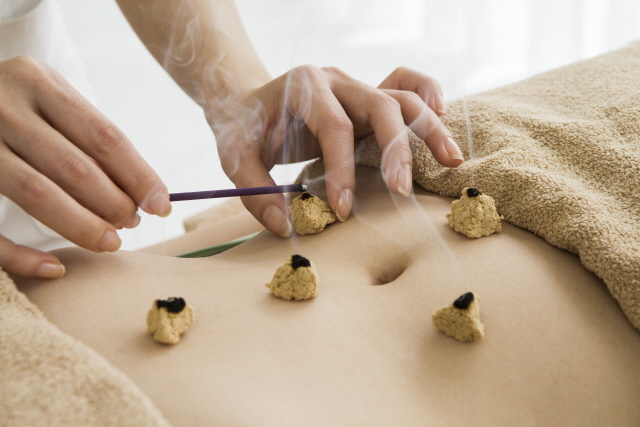Written by Jeonghwa Lee, Choonjae Lee, Published by Korea Institute of Oriental Medicine
C. Moxibustion
Moxibustion treats diseases through thermal stimulation by burning herb at a specific spot on the skin or exposing the spot to heat from the burning. The most commonly used herb is mugwort. Besides, any type of thermal stimulation may fall into the category of moxibustion though it does not involve burning.
The origin of moxibustion is not certain, but it is conjectured that in ancient times people might experience the healing or easing of diseases as they were exposed to fire and find the effect of moxibustion.
Historical records on moxibustion are found in Hwangjenaegyeong. There are also old medical books recording detailed clinical experiences in moxibustion as an essential therapy prescribed together with acupuncture.
The effect of moxibustion is attained through thermal stimulation, and in particular the effect of far infrared ray is high. Accordingly, it is effective in all diseases with the nature of chill and cold. In addition, while acupuncture controls the
vigor of the body, moxibustion invigorates the body, so it is effective in debilitative diseases and chronic diseases.
Furthermore, it produces effects such as facilitating the functions of cell systems, strengthening immunological functions, increasing hemoglobin in red blood cells, stopping bleeding, alleviating pains and removing pathological tissues, and is effective in hypertension, arteriosclerosis, anemia, gastric ulcer, urticaria, etc.
D. Cupping
People often say, Do cupping or attach cups when they have neuralgia or a bruise. Cupping is a kind of treatment method in TKM, which removes waste matters from the body and restores normal body functions.
Cupping uses small vessels. In ancient times before the development of the tool, people used a bamboo tree, cutting it, expanding air in the hole by putting water into the hole and boiling the water or making a fire inside the hole, and attaching it to the skin. As the air cools down, its volume is reduced and creates negative pressure, which removes bad blood or pus stagnant under the skin. Today, however, negative pressure is created using a manual or an electromotive device. As its application has been broadened, it is used widely from traumatic diseases like minor bruises to chronic internal diseases.
Cupping has not been used only in Asia. It is said that Napoleon was treated with cupping using the horns of water buffalo for his stomachache. In addition, highclass people in Europe are also known to have used cupping regularly for recovery
from fatigue and rejuvenation.
Cupping is divided into two types: wet cupping for extracting body fluid like blood; and dry cupping for applying negative pressure locally without extracting body fluid. Dry cupping uses the property of the skin that passes gas but not blood. Therefore, if negative pressure is applied through cupping, the pressure difference causes gas exchange and purifies body fluid.
Cupping therapy has various effects. First, it activates metabolism and blood purification through gas exchange. Second, it strengthens blood circulation and hematopoiesis. Third, it supplies nutrients to each cell and discharges waste matters
and toxic substances. Besides, cupping is known to contribute to the equilibrium of acidity and alkalinity in body fluid and immunological functions.
E. Qigong
Qigong is a kind of body training regimen for a long healthy life. It trains the body through the control of posture, breathing, the relaxation of body and mind, the concentration of will, rhythmical motions, etc. Through those activities,
qigong aims at controlling and strengthening functions in each organ and system of the body, inducing and developing
the potentials of the body, and ultimately preventing and treating diseases and attaining healthy and long life.
Qigong training is composed of three elements: body training for right posture and motion, breath training for controlling breath, and mind training for bracing up the mind. All the three elements should be trained together.
Qigong is divided into health qigong and martial arts qigong. Health qigong adopts relatively gentle training methods. Therefore, it is called soft qigong and suitable for all people regardless of age including those with weak constitution and chronic diseases. Martial arts qigong adopts intensive training methods, so is called hard qigong. It is suitable for young people who want to drill their body and maximize their physical strength.
Health qigong is again divided into two types. One is for preserving health through promoting health, improving constitution, preventing diseases, and bracing up the spirit, and the other is for treating diseases that have already broken
out. However, this division is clear. On the other hand, hard qigong, or martial arts qigong, purposes to attain effects through martial arts training. Hard qigong is also divided into ganggong, yugong and gyeonggong, but in China they are collectively called pyoyeongong.
The term qigong has been used in today’s meaning since 1950 in China. However, the contents of qigong have been handed down through thousands of years. Thus, qigong can be said to be the oldest health training in human history.

































